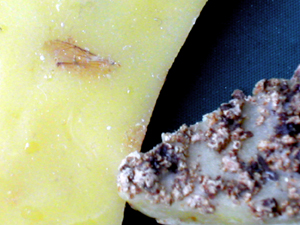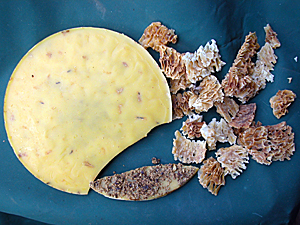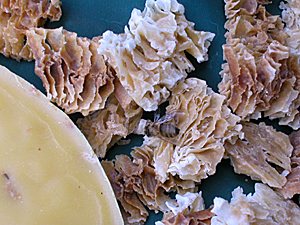 The three main products of the hive are (in approximate order) pollination, honey, and beeswax. The first is a service that my bees perform mostly for trees, wildflowers, and nearby urban gardeners, though the wild birds are probably pretty happy about the extra berries and fruits in the neighborhood. This year, the honey crop boils down to the pair of one-pint mason jars I entered in the fair, though it seems that the girls produced enough that we could have extracted more after all. Beeswax, however, still harbors some mysteries for me.
The three main products of the hive are (in approximate order) pollination, honey, and beeswax. The first is a service that my bees perform mostly for trees, wildflowers, and nearby urban gardeners, though the wild birds are probably pretty happy about the extra berries and fruits in the neighborhood. This year, the honey crop boils down to the pair of one-pint mason jars I entered in the fair, though it seems that the girls produced enough that we could have extracted more after all. Beeswax, however, still harbors some mysteries for me.As a beginner, I found myself fumbling around with little bits of wax that did not seem worth keeping at the time, or which were curiousities I could show to friends at dinner parties. They mostly got lost along the way. As the colonies grew and I felt more confident, I saved a little, and began to wonder what to do with it.
 It turns out that most clued-in beekeepers have something called a solar wax melter into which they dump the beeswax bits and parings over the year, and the sun turns them into a lovely little pool of wax. Upon asking where one gets such a thing, most of the beekeepers in my club start going on about table saws and routers and all those things that I don't have in my basement, but perhaps I can buy one next year...preassembled like all my other bee gear. The second picture gives you an idea of how beeswax scrapings compare to melted wax. The variance in color is ultra cool, to my mind. The bees have dirty little feet from running around in the same world in which we live, and the wax varies in color depending on whether it is from a comparative bee highway, or maybe a newly paved suburban cul de sac.
It turns out that most clued-in beekeepers have something called a solar wax melter into which they dump the beeswax bits and parings over the year, and the sun turns them into a lovely little pool of wax. Upon asking where one gets such a thing, most of the beekeepers in my club start going on about table saws and routers and all those things that I don't have in my basement, but perhaps I can buy one next year...preassembled like all my other bee gear. The second picture gives you an idea of how beeswax scrapings compare to melted wax. The variance in color is ultra cool, to my mind. The bees have dirty little feet from running around in the same world in which we live, and the wax varies in color depending on whether it is from a comparative bee highway, or maybe a newly paved suburban cul de sac.  Even after you melt the wax, however, there is this small problem of bee bits. The top photo shows a beeswing preserved in wax. I opted to melt a handful of beeswax in water using a double boiler, and got a lovely yellow disk with the odd bee leg or wing floating near the top, and some undefined scunge on the bottom (I broke a bit and turned it over so you could see).
Even after you melt the wax, however, there is this small problem of bee bits. The top photo shows a beeswing preserved in wax. I opted to melt a handful of beeswax in water using a double boiler, and got a lovely yellow disk with the odd bee leg or wing floating near the top, and some undefined scunge on the bottom (I broke a bit and turned it over so you could see). Now, beeswax candles take much more wax than I collected this year, so I have the alternative of making neat-o projects like lip balms and lotions. I have enough for that. Folks seem less inclined to use face cream that has bee legs in it, though, not to mention anonymous brown bumps. So I need to figure out what to do.
Apparently, most beekeepers pare off the brown stuff, which I suppose I could do, and sweatshirting is a good filter for the bee bits. After the paring and the filtering, though, I wonder what I possibly could have left.
All this may result in a cosmetic achievement which is only the size of a ChapStick, but if there is any, you will see it here.
No comments:
Post a Comment